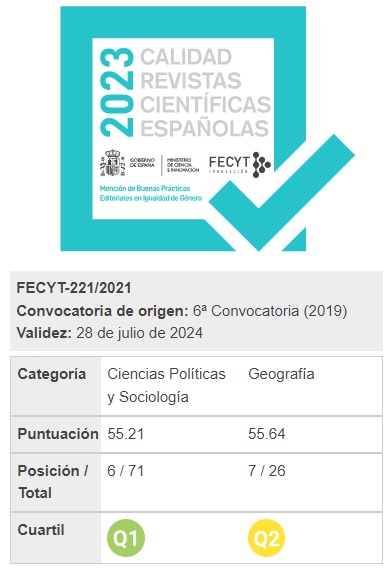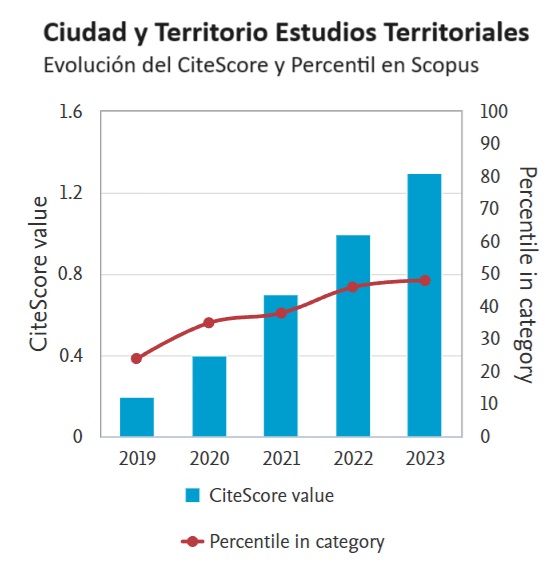Recovering the urban concept of district. Urban units and urban regeneration in Castile and Leon
Keywords:
Urban units, urban regeneration, district, integrated urban development, Castile and Leon, ValladolidAbstract
The growing importance of urban regeneration —Law 8/2013, on Urban Rehabilitation, Regeneration and Renovation and Autonomous Community Laws— requires a more precise and coherent organisation of the urbanised land in the existing city. Some Autonomous Communities have been introducing novel concepts regarding sectoring urban land, and its usefulness for urban regeneration may be essential. In particular, Castile and León has proposed the concept of the “urban units”, whose conditions and possibilities are intended to be analysed, also evaluating the perspectives opened up by other Autonomous Community legislations. To achieve this, the focus on the urban units in the revision work of the General Urban Plan of Valladolid is presented, trusting in the possibilities of this concept. The methodology applied in order to evaluate its urban conditions —density, facilities, etc.— is also shown. Previously disciplinary antecedents such as the neighbourhood unit are analysed. After a synthesis of the analogies in other Autonomous Communities legislation, the criteria defining the urban units in Castile and Leon are addressed as its urban legislation has been innovative as regards boosting urban regeneration. This demonstrates the usefulness of the concept of urban units for the diagnosis of the consolidated urban space, but also its role as an instrument for the organisation of the urbanised land which, starting from an integral vision of the existing city, facilitates the regeneration of its spaces. The dynamism of urban legislation cannot ignore this practice and must not forget that, as proposed by the integrated approach, it is capable of linking society with the policies aimed at making the city more liveable.
Downloads
Downloads
Published
How to Cite
Issue
Section
License
Copyright (c) 2017 Juan Luis de las Rivas Sanz, Miguel Fernández-Maroto, Enrique Rodrigo González, Mónica Martínez Sierra

This work is licensed under a Creative Commons Attribution-NonCommercial-NoDerivatives 4.0 International License.
Considering the provisions of the current legislation on Intellectual Property, and in accordance with them, all authors publishing in CyTET give -in a non-exclusive way and without time limit- to the Ministry of Transport, Mobility and Urban Agenda the rights to disseminate, reproduce, communicate and distribute in any current or future format, on paper or electronic, the original or derived version of their work under a Creative Commons Attribution-NonCommercial-NoDerivative 4.0 license International (CC BY-NC-ND 4.0), as well as to include or assign to third parties the inclusion of its content in national and international indexes, repositories and databases, with reference and recognition in any case of its authorship.
In addition, when sending the work, the author(s) declares that it is an original work in which the sources that have been used are recognized, committing to respect the scientific evidence, to no longer modify the original data and to verify or refute its hypothesis. Author(s) also declare that the essential content of the work has not been previously published nor will it be published in any other publication while it is under evaluation by CyTET; and that it has not been simultaneously sent to another journal.
Authors must sign a Transfer of Rights Form, which will be sent to them from the CyTET Secretariat once the article is accepted for publication.
With the aim of promoting the dissemination of knowledge, CyTET joins the Open Journal Access (OA) movement and delivers all of its content to various national and international indexes, repositories and databases under this protocol; therefore, the submission of a work to be published in the journal presupposes the explicit acceptance by the author of this distribution method.
Authors are encouraged to reproduce and host their work published in CyTET in institutional repositories, web pages, etc. with the intention of contributing to the improvement of the transfer of knowledge and the citation of said works.







